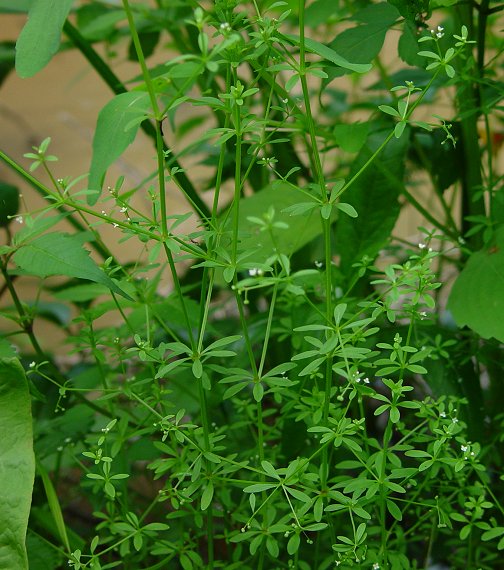Galium tinctorium L.
Southern Three-Lobed Bedstraw

Native
CC = 6
CW = -5
MOC = 44
© DETenaglia
Galium tinctorium L.Southern Three-Lobed Bedstraw | |
 |
Native CC = 6 CW = -5 MOC = 44 |
© DETenaglia |
|
Family - Rubiaceae Habit - Perennial forb. Stems - Spreading to loosely ascending, to 50 cm, weak and often trailing, clambering on other vegetation, and/or matted, usually well-branched, pubescent with short, spreading hairs at the nodes, otherwise glabrous or rarely sparsely roughened with minute, downward-angled hairs on the angles.
Leaves - Whorled, 4-6 per node, more or less spreading in orientation. Leaf blades 5-20 mm long, 1-5 mm wide, narrowly elliptic to narrowly oblanceolate or linear, rounded or angled to a bluntly pointed tip, the midvein not extended into a point, angled at the base, the undersurface not glandular, glabrous or sparsely roughened with minute, stout, pricklelike hairs along the midvein, the venation with only the midvein visible, the margins glabrous or roughened with minute, ascending to spreading hairs, slightly to moderately curled under.
Inflorescences - Terminal and usually also axillary from the upper leaves, not pendant, positioned over the leaves, usually consisting of small (0.5-1.5 cm long), stalked clusters. Flowers 2 or 3, rarely solitary, the stalks 1-10 mm long.
Flowers - Corollas 0.8-1.2 mm long, 3-or less commonly 4-lobed (the number often variable on a single plant), white.
Fruits - Schizocarps 1.5-2.0 mm long, 2.5-3.0 mm wide, the surface glabrous, smooth.
Flowering - May - September. Habitat - Bottomland forests, swamps, pond margins, marshes, fens, sloughs, bottomland prairies, mesic swales of upland prairies, ditches. Origin - Native to the U.S. Other info. - This species can be found scattered throughout the state, but most commonly in the southern half and Ozark region. Beyond Missouri it is found across the eastern half of the continental U.S. The plant is recognized by its whorls of 4-6 relatively short, narrow leaves, very small white flowers having 3 or 4 lobes (often with both flower types on the same plant), and smooth ovaries and fruits. It is always found in wet locations, which is another clue to its identity. Photographs taken in Brown Summit, NC., 7-14-02 (DETenaglia); also along the Katy Trail near Dutzow, Warren County, MO, 7-29-2022 (SRTurner). |